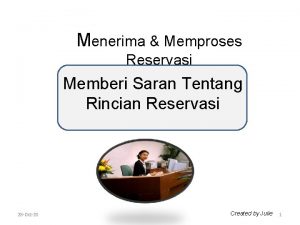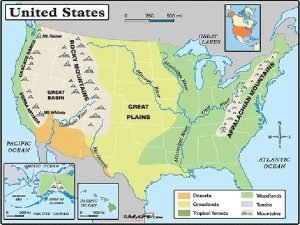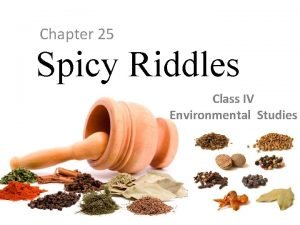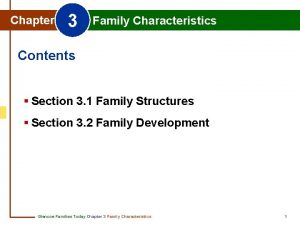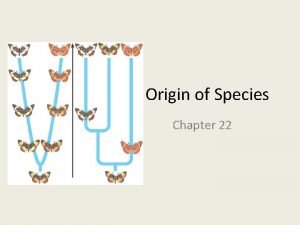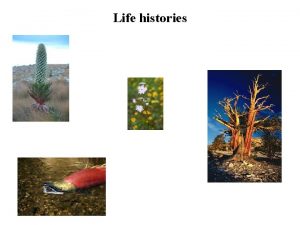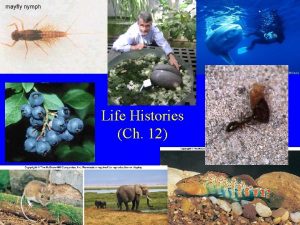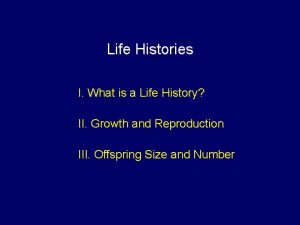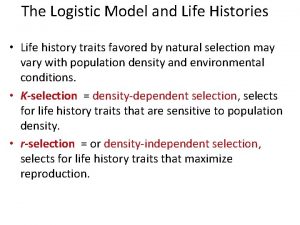III Life Histories Chap 12 A Life history


















- Slides: 18

III. Life Histories (Chap. 12) A. Life history traits B. Tradeoffs in resource allocation C. Life history strategies A. Life History Traits

Copyright © The Mc. Graw-Hill Companies, Inc. Permission required for reproduction or display. Adult fish mortality and reproductive effort Figure 12. 13 12 -10 Source: Gunderson 1997

Copyright © The Mc. Graw-Hill Companies, Inc. Permission required for reproduction or display. Survival ratio and reproductive effort Figure 12. 18 12 -14 Source: Bertschy and Fox 1999

1. Reproductive allocation vs. growth/survival - limited resources - reproduction is energetically expensive - different reproductive strategies a. frequent disturbances b. stable environments

Reproduction vs. growth tradeoffs: examples Douglas fir Red deer Fruit flies

B. Tradeoffs 2. # of offspring vs. individual fitness a. body size of offspring vs. # of offspring b. # of offspring vs. amount of parental care for each

Copyright © The Mc. Graw-Hill Companies, Inc. Permission required for reproduction or display. Female darter size and number of eggs Figure 12. 3 12 -1 Source: Turner and Trexler 1998

Copyright © The Mc. Graw-Hill Companies, Inc. Permission required for reproduction or display. Size of eggs and number of eggs Figure 12. 4 12 -2 Source: Turner and Trexler 1998

Copyright © The Mc. Graw-Hill Companies, Inc. Permission required for reproduction or display. Seed mass and seed number Figure 12. 7 12 -4 Source: Stevens 1932

Copyright © The Mc. Graw-Hill Companies, Inc. Permission required for reproduction or display. Seed mass and seedling height Figure 12. 11 12 -8 Source: Seiwa and Kikuzawa 1991

C. Life History Strategies 1. r-selected vs. K-selected 2. Grime’s CSR

r- vs K-selection r-selection K-selection A. Disturbance Common, irregular B. Mortality Variable, unpredictable Constant, predictable C. Competition Low or variable High, constant D. Pop. size Variable, below K Rel. constant, near K E. Consequence High r Good competitors Rarer, more regular

Small size Rapid growth Early reproduction Many, small offspring Large size Slow growth Late reproduction Few, large offspring

K vs. r selection: extremes in parental care Humpback whales Sea urchins

K vs. r selection: extremes

r vs. K selection: Cattails

Copyright © The Mc. Graw-Hill Companies, Inc. Permission required for reproduction or display. Plant life history strategies – Grime’s CSR Figure 12. 20 12 -15 Source: after Grime 1979

End
 Chap chap slide
Chap chap slide Biographical research design
Biographical research design Hamlet act iii scene ii
Hamlet act iii scene ii Sacred seven radiology
Sacred seven radiology Menerima dan memproses reservasi
Menerima dan memproses reservasi Charles dickens song horrible histories
Charles dickens song horrible histories Where was the first permanent english colony
Where was the first permanent english colony North america, family histories, 1500-2000
North america, family histories, 1500-2000 Style chapter 1
Style chapter 1 Passion chap 6
Passion chap 6 Bank run chap 11
Bank run chap 11 Autocorrelation in econometrics
Autocorrelation in econometrics Leaf riddle
Leaf riddle Kstn chap 18
Kstn chap 18 Close family chapter 3
Close family chapter 3 Origin of species chapter 24 bl
Origin of species chapter 24 bl Satisfying needs chapter 1
Satisfying needs chapter 1 Origin of species manhwa chapter 22
Origin of species manhwa chapter 22 Mad dog tkam
Mad dog tkam




